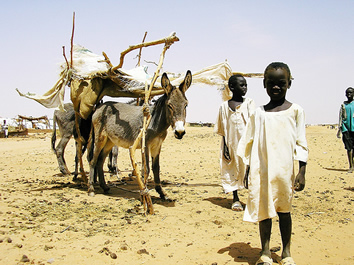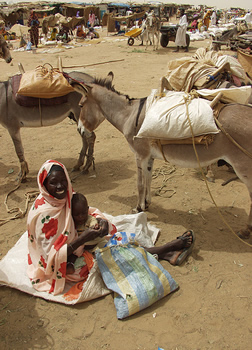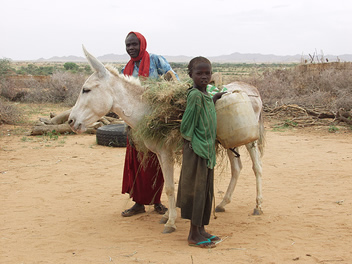 Last month I attended a seminar on the human-equine bond held at the Cummings School of Veterinary Medicine at Tufts University. The attraction for me was two speakers from the United Kingdom. Because a sub-theme of the meeting was equine rescue, I knew it was possible that their view of the relationship, while equally intense, could be more comprehensive than is sometimes the case in this country.
Last month I attended a seminar on the human-equine bond held at the Cummings School of Veterinary Medicine at Tufts University. The attraction for me was two speakers from the United Kingdom. Because a sub-theme of the meeting was equine rescue, I knew it was possible that their view of the relationship, while equally intense, could be more comprehensive than is sometimes the case in this country.
I was not disappointed.
Derek Knottenbelt, OBE, BVMS,DVMS, DipECEIM, MRCVS, is an equine specialist with enough initials after to his name to give anyone the vapors. I mention this because in spite of the fact that he undoubtedly possesses the knowledge signaled by all those credentials plus a lot more, there was nothing the least bit pompous or unapproachable about him. Quite the contrary, he passed my test for someone you’d want to be handling an extremely complex problem: In addition to possessing a great deal of knowledge and an empathetic nature, he also possesses a wonderful sense of humor.
Dr Knottenbelt divides his time between his work as a specialist in equine internal medicine often treating the equine elite, and treating working donkeys and ponies belonging to the most devastatingly poor living under the worst conditions. Because of this, his view of the human-equine bond is quite different from that more commonly held by residents of industrialized societies.
For example, most people who live in developed countries who like horses, donkeys, and/or mules have strong ideas about how the owners or guardians of those animals should treat them. More often than not, this consists of a list of obligations, such as providing access to fresh, clean water and what they consider a balanced diet in adequate amounts, certain vaccinations, routine worming, gelding/castration of males at the appropriate time. In these people’s minds, anyone who doesn’t fulfill these obligations most certainly doesn’t value the animal and is most certainly guilty of animal cruelty.
 Dr Knottenbelt’s presentation challenged participants to think outside this very small box by presenting us with some real world therapy. Of the approximately 110 million equids worldwide, only 10 million of these live in developed countries. There, the majority are companion animals or those used in various equine sports. While these animals may greatly benefit their individual owners in one way or another and while some of their owners or guardians may think they’d die without them, in general these are leisure animals. Even so, because these animals play what I would define as a primarily symbolic role in developed societies, all kinds of organizations exist to ensure their welfare, including the services of about 95% of the world’s equine veterinary population.
Dr Knottenbelt’s presentation challenged participants to think outside this very small box by presenting us with some real world therapy. Of the approximately 110 million equids worldwide, only 10 million of these live in developed countries. There, the majority are companion animals or those used in various equine sports. While these animals may greatly benefit their individual owners in one way or another and while some of their owners or guardians may think they’d die without them, in general these are leisure animals. Even so, because these animals play what I would define as a primarily symbolic role in developed societies, all kinds of organizations exist to ensure their welfare, including the services of about 95% of the world’s equine veterinary population.
This is the standard we impose on owners of horses, donkeys, and mules in other countries.
But the life of the bulk of the equid population is simultaneously much grimmer and much more meaningful. Who but the most cold-hearted could watch videos of practically skeletal little donkeys or ponies pulling impossibly large loads without access to food or water? How tempting to zip up to the top of our western holier-than-thou soapboxes and condemn the person who treats an animal that way! Oh, and the guy beating the little donkey to make him move faster? So many visions of orchestrating a slow and horrible death for that bastard spring to mind as fast as a knee hit with a rubber mallet just so flies upward.
But Derek Knottenbelt denied us those simplistic pleasures by presenting us with real-world facts. The knee-jerk response that these people obviously don’t value their animals fell flat when we learned that the cost of a working donkey in Mali is $450. That may not seem like a lot until you compare that amount to the average family income of $200 a year.
“Well,” you might say, “if the animals cost so much, why don’t they take better care of them?” We can take this one step further and add that oh-so-common holier-than-thou proclamation: “If they can’t afford to take care of the animals, they shouldn’t be allowed to have them.”
Reality Check 1: The animals don’t have enough to eat and drink because the people don’t have enough to eat and drink.
Reality Check 2: In order to provide the very little the people have, the animals have to work.
Reality Check 3: If the animals can’t work, the women and children will have to do the animal’s work.
Reality Check 4: If the children have to do the animals’ work, they can’t go to school.
Reality Check 5: If the children can’t go to school, they can’t learn how to better their own and their animals’ lot in life.
Think about that. The same conditions that are trapping these animals are trapping the people who depend on them: poverty, necessity, and ignorance. As Knottenbelt summed it up so elegantly, “The question is not, ‘How soon can we stop the use of animals?’ but ‘How can we make the lives of the animals better and in doing so how can we improve the lives of the people?’ Wouldn’t it make more sense to ensure a quality life for 100 million working animals and all the benefits that this would gain their owners and their children than replace those animals with 100 million fossil-fuel consuming and exhaust-belching, non-biodegradable vehicles?
Listening to Dr Knottenbelt once again made me realize how anathema the idea of helping people in order to help their animals often is in our society. Put another way, how little value we place on the power of the human-animal bond. Instead, we want to punish those who don’t treat animals the way we think they should be treated. If that means a 6-year-old child will have to quit school and haul more than 8 gallons (+64 pounds) of water and make a 4-mile circuit to the water source 3 times a day to do so, we irrationally, and cruelly, say, “That’ll teach them not to treat their animals like that!”
Fortunately for the planet and the humans and animals in developing countries, to say nothing of the preservation of an equitable human-animal bond with all its benefits for both, people like Derek Knottenbelt don’t share that view. His goal and that of organizations like the Society for the Protection of Animals Abroad (SPANA) is twofold. First, to accept the vital role these animals play in these societies. And second, to provide those living in these societies with the education that will enable those animals to fulfill their function in a reliable and safe way. The result of such programs is a win-win situation for the animals and their owners.
What’s not to like?
 What left me feeling so sad as I made the long drive home after the seminar is the awareness that for some in the animal rights and welfare community in our society, there is a crucial “something” not to like about such a program. Unfortunately, some of these people don’t want anyone to benefit except the poorly cared for animals. While I’d be the last to say that these folks don’t like animals, I can’t help thinking that their desire to punish people is sometimes the much stronger motivating force.
What left me feeling so sad as I made the long drive home after the seminar is the awareness that for some in the animal rights and welfare community in our society, there is a crucial “something” not to like about such a program. Unfortunately, some of these people don’t want anyone to benefit except the poorly cared for animals. While I’d be the last to say that these folks don’t like animals, I can’t help thinking that their desire to punish people is sometimes the much stronger motivating force.
Thanks to the good folks at SPANA, I’ve included some photos from their collection here. I chose pictures from Darfur because most of us are familiar with the deplorable human and animals conditions in that part of the world. To me, these demonstrate the spirit and resilience of these people and animals who live in cruel conditions most of us can’t even begin to comprehend. These pictures also demonstrate how even a little help in areas where there’s none can have dramatic results. When I look at these animals and people I can’t help but think that theirs is a bond that comes close to reflecting the epitome that Henry Beston pleaded for years ago in The Outmost House:
They are not brethren, they are not underlings; they are other nations, caught with ourselves in the net of life and time, fellow prisoners of the splendor and travail of the earth.
Claiming to speak only for the animals is like the sound of one hand clapping. It may have some emotional meaning that is deeply satisfying for the person doing it. But in terms of making meaningful changes where they’re needed the most, helping only the animals is doing only half of the job.
If you have any comments regarding subject matter, favorite links, or anything you’d like to see discussed on or added to this site, please let me know at mm@mmilani.com.
I was not disappointed.
Derek Knottenbelt, OBE, BVMS,DVMS, DipECEIM, MRCVS, is an equine specialist with enough initials after to his name to give anyone the vapors. I mention this because in spite of the fact that he undoubtedly possesses the knowledge signaled by all those credentials plus a lot more, there was nothing the least bit pompous or unapproachable about him. Quite the contrary, he passed my test for someone you’d want to be handling an extremely complex problem: In addition to possessing a great deal of knowledge and an empathetic nature, he also possesses a wonderful sense of humor.
Dr Knottenbelt divides his time between his work as a specialist in equine internal medicine often treating the equine elite, and treating working donkeys and ponies belonging to the most devastatingly poor living under the worst conditions. Because of this, his view of the human-equine bond is quite different from that more commonly held by residents of industrialized societies.
For example, most people who live in developed countries who like horses, donkeys, and/or mules have strong ideas about how the owners or guardians of those animals should treat them. More often than not, this consists of a list of obligations, such as providing access to fresh, clean water and what they consider a balanced diet in adequate amounts, certain vaccinations, routine worming, gelding/castration of males at the appropriate time. In these people’s minds, anyone who doesn’t fulfill these obligations most certainly doesn’t value the animal and is most certainly guilty of animal cruelty.
This is the standard we impose on owners of horses, donkeys, and mules in other countries.
But the life of the bulk of the equid population is simultaneously much grimmer and much more meaningful. Who but the most cold-hearted could watch videos of practically skeletal little donkeys or ponies pulling impossibly large loads without access to food or water? How tempting to zip up to the top of our western holier-than-thou soapboxes and condemn the person who treats an animal that way! Oh, and the guy beating the little donkey to make him move faster? So many visions of orchestrating a slow and horrible death for that bastard spring to mind as fast as a knee hit with a rubber mallet just so flies upward.
But Derek Knottenbelt denied us those simplistic pleasures by presenting us with real-world facts. The knee-jerk response that these people obviously don’t value their animals fell flat when we learned that the cost of a working donkey in Mali is $450. That may not seem like a lot until you compare that amount to the average family income of $200 a year.
“Well,” you might say, “if the animals cost so much, why don’t they take better care of them?” We can take this one step further and add that oh-so-common holier-than-thou proclamation: “If they can’t afford to take care of the animals, they shouldn’t be allowed to have them.”
Reality Check 1: The animals don’t have enough to eat and drink because the people don’t have enough to eat and drink.
Reality Check 2: In order to provide the very little the people have, the animals have to work.
Reality Check 3: If the animals can’t work, the women and children will have to do the animal’s work.
Reality Check 4: If the children have to do the animals’ work, they can’t go to school.
Reality Check 5: If the children can’t go to school, they can’t learn how to better their own and their animals’ lot in life.
Think about that. The same conditions that are trapping these animals are trapping the people who depend on them: poverty, necessity, and ignorance. As Knottenbelt summed it up so elegantly, “The question is not, ‘How soon can we stop the use of animals?’ but ‘How can we make the lives of the animals better and in doing so how can we improve the lives of the people?’ Wouldn’t it make more sense to ensure a quality life for 100 million working animals and all the benefits that this would gain their owners and their children than replace those animals with 100 million fossil-fuel consuming and exhaust-belching, non-biodegradable vehicles?
Listening to Dr Knottenbelt once again made me realize how anathema the idea of helping people in order to help their animals often is in our society. Put another way, how little value we place on the power of the human-animal bond. Instead, we want to punish those who don’t treat animals the way we think they should be treated. If that means a 6-year-old child will have to quit school and haul more than 8 gallons (+64 pounds) of water and make a 4-mile circuit to the water source 3 times a day to do so, we irrationally, and cruelly, say, “That’ll teach them not to treat their animals like that!”
Fortunately for the planet and the humans and animals in developing countries, to say nothing of the preservation of an equitable human-animal bond with all its benefits for both, people like Derek Knottenbelt don’t share that view. His goal and that of organizations like the Society for the Protection of Animals Abroad (SPANA) is twofold. First, to accept the vital role these animals play in these societies. And second, to provide those living in these societies with the education that will enable those animals to fulfill their function in a reliable and safe way. The result of such programs is a win-win situation for the animals and their owners.
What’s not to like?
Thanks to the good folks at SPANA, I’ve included some photos from their collection here. I chose pictures from Darfur because most of us are familiar with the deplorable human and animals conditions in that part of the world. To me, these demonstrate the spirit and resilience of these people and animals who live in cruel conditions most of us can’t even begin to comprehend. These pictures also demonstrate how even a little help in areas where there’s none can have dramatic results. When I look at these animals and people I can’t help but think that theirs is a bond that comes close to reflecting the epitome that Henry Beston pleaded for years ago in The Outmost House:
They are not brethren, they are not underlings; they are other nations, caught with ourselves in the net of life and time, fellow prisoners of the splendor and travail of the earth.
Claiming to speak only for the animals is like the sound of one hand clapping. It may have some emotional meaning that is deeply satisfying for the person doing it. But in terms of making meaningful changes where they’re needed the most, helping only the animals is doing only half of the job.
If you have any comments regarding subject matter, favorite links, or anything you’d like to see discussed on or added to this site, please let me know at mm@mmilani.com.